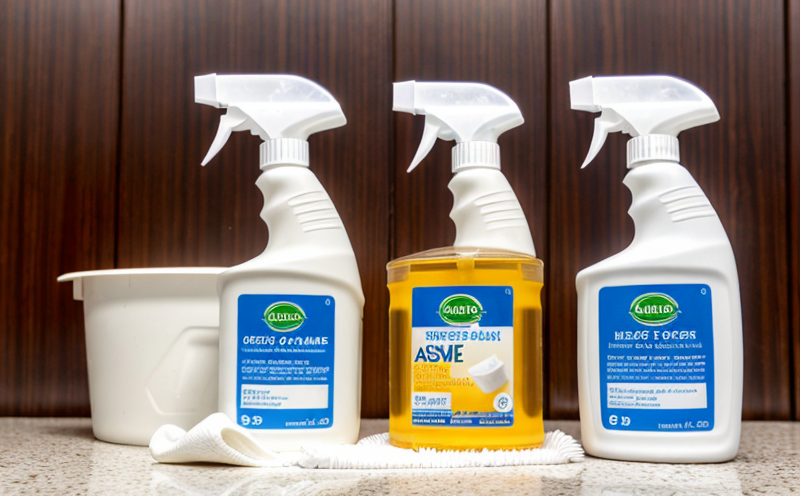ASTM D3519 Surfactant Residue Testing in Detergents
The ASTM D3519 standard provides a method to determine the concentration of surfactants remaining after washing with detergents. This is crucial for ensuring that cleaning products are effective yet safe for use, especially in environments where hygiene and health are paramount.
Detergent formulations must balance performance against safety and environmental impact. Surfactant residues can influence water quality, soil biota, and human health. ASTM D3519 helps manufacturers ensure their products meet the necessary standards to prevent harmful effects on both indoor users and outdoor ecosystems.
The testing process involves washing a specified amount of material with a known quantity of detergent under controlled conditions. The sample is then analyzed for residual surfactant concentration using spectrophotometric methods or other suitable analytical techniques. This method is widely recognized and used globally, providing consistency in the evaluation of cleaning products' performance.
By adhering to ASTM D3519, manufacturers can demonstrate compliance with relevant regulations and industry standards. This ensures that their products are not only effective but also safe for consumers and the environment. The test results provide a clear indication of surfactant levels, allowing for informed decision-making in product development.
Understanding the implications of surfactant residues is essential for quality managers and compliance officers. R&D engineers can use these insights to innovate more sustainable formulations. For procurement teams, ensuring adherence to ASTM D3519 helps maintain supply chain integrity by selecting products that meet stringent performance criteria.
The test method also plays a critical role in the validation of new product formulations. By measuring surfactant residues post-wash, manufacturers can identify optimal detergent concentrations and washing conditions. This not only enhances cleaning efficiency but also minimizes environmental impact by reducing unnecessary chemical usage.
ASTM D3519 is part of a broader suite of standards that guide the development and evaluation of cleaning products. These standards ensure consistency in testing methodologies, which is vital for regulatory compliance and market acceptance. The ongoing evolution of these standards reflects the industry's commitment to innovation and sustainability.
In summary, ASTM D3519 Surfactant Residue Testing in Detergents is a cornerstone of quality assurance in the cleaning and hygiene product sector. It ensures that products not only meet performance expectations but also contribute positively to environmental health.
Industry Applications
The ASTM D3519 test has wide-ranging applications across various industries, particularly those dealing with cleaning and hygiene products. In the pharmaceutical industry, ensuring surfactant levels in antiseptics is critical for efficacy and safety. Similarly, in the food processing sector, cleanliness of equipment and utensils is paramount to prevent contamination.
For household goods manufacturers, ASTM D3519 helps ensure that laundry detergents and dishwashing liquids meet stringent cleanliness standards without leaving harmful residues. This is especially important given increasing consumer awareness about environmental sustainability. In institutional settings like hospitals and schools, the test ensures that cleaning products are effective yet safe for use by personnel.
ASTM D3519 also supports the textile industry in developing effective fabric care products while minimizing environmental impact. For construction companies, it aids in ensuring that cleaning agents used in facilities do not pose risks to workers or the environment.
The versatility of ASTM D3519 makes it a valuable tool across multiple sectors. It provides a standardized approach to measuring surfactant residues, which is essential for maintaining high standards of hygiene and safety.
Why Choose This Test
Selecting ASTM D3519 Surfactant Residue Testing in Detergents offers numerous advantages that are critical for quality assurance and product development. One key benefit is the ability to ensure compliance with international standards, which enhances market access and consumer trust.
- International Recognition: Adherence to ASTM D3519 aligns your products with global best practices, making it easier to meet regulatory requirements in different markets.
- Quality Assurance: The test provides a reliable method for assessing surfactant levels, ensuring that cleaning products are effective and safe for use.
- Sustainability Focus: By minimizing surfactant residues, manufacturers can reduce environmental impact while maintaining product performance.
- Innovation Support: The standardized testing process allows for consistent evaluation of new formulations, facilitating innovation in product development.
The test also offers a transparent approach to quality control, allowing companies to demonstrate their commitment to high standards. This can be particularly beneficial in competitive markets where customer trust is crucial.
In conclusion, choosing ASTM D3519 Surfactant Residue Testing in Detergents is an informed decision that supports both regulatory compliance and product excellence. It ensures that your products meet the highest quality and safety standards, thereby enhancing your brand reputation and market position.
Environmental and Sustainability Contributions
The ASTM D3519 test contributes significantly to environmental sustainability by promoting the reduction of surfactant residues in cleaning products. This has a direct impact on water quality and soil health, both of which are critical for maintaining ecological balance.
- Water Quality: By minimizing surfactant levels, ASTM D3519 helps prevent contamination of aquatic ecosystems. Excessive surfactants can disrupt the natural pH balance in water bodies, affecting aquatic life and human health.
- Soil Health: Surfactant residues can accumulate in soil, leading to reduced fertility and increased microbial activity that may harm beneficial organisms. ASTM D3519 helps mitigate these effects by ensuring effective washing processes.
The test also supports the development of more sustainable cleaning products. By measuring surfactant residues post-wash, manufacturers can identify optimal detergent concentrations and washing conditions, reducing unnecessary chemical usage and lowering overall environmental impact.
Furthermore, ASTM D3519 aligns with broader sustainability goals by encouraging innovation in product formulation. Manufacturers can explore more eco-friendly alternatives that maintain cleaning efficacy while minimizing environmental harm.
In summary, the ASTM D3519 test plays a vital role in promoting environmental stewardship through effective and sustainable cleaning practices.





